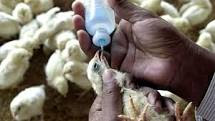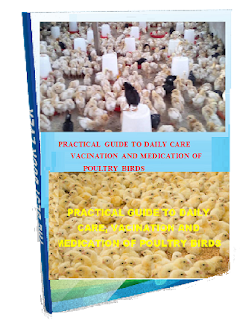Poultry Diseases & Medications For Small Flocks
Signs are coughing, sneezing, and sudden deaths.
One celled parasite - coccidia - 9 species.
Host specific; immunity specific.
Coccidia - need moisture, O2, and temperature.
Prevent by keeping birds dry; feed 0.0125% Amprol continuously to 8 weeks of age.
Amprol @ 1/3 oz. Powder/gallon water 10-14 days for treatment.
ROUNDWORMS - Very common p larger worms.
Decreased egg production; direct life cycle - 28 days.
Piperazine for 12-24 hours - 50mg/lb body weight.
Meldane feed 18-21 days.
CAPILLARIA WORMS - Common. Small hairworm.
Decreased egg
production; pale yolks; poor hatchability.
Add extra Vitamin A - 12,000 I.U. / pound feed 3 weeks.
Meldane feed 18-21 days.
Add extra Vitamin A - 12,000 I.U. / pound feed 3 weeks.
Meldane feed 18-21 days.
LICE, MITES - Common parasites of skin and feathers.
Cause anemia due
to loss of blood.
Decrease egg production and can produce mortality.
Dust or spray with Sevin.
Must hand dust the males. Females will dust themselves.
Decrease egg production and can produce mortality.
Dust or spray with Sevin.
Must hand dust the males. Females will dust themselves.
MAREK'S DISEASE - Cancer of the chicken; NOT contagious to
humans.
Mortality can go to 20%.
No treatment; prevention by day old vaccination at hatchery.
RESPIRATORY DISEASES - Very common in Connecticut.
Infectious
Bronchitis - Sneezing, decrease in egg production and
egg shell quality.
Newcastle
Disease - Sneezing, decrease in egg production and
internal egg quality.
Infectious
Laryngotracheitis - Sneezing, coughing, choking, high
losses.
Pox - Cause respiratory signs if pox lesions in
mouth, throat, and windpipe; skin lesions on comb and face.
Prevent:
fowl pox vaccine
Treatment:
Treat with POX CARE
Terramycin (Oxytetracycline) - safe; use @ 200 mg. To
1000 mg. (1 Gm.) per gallon water; withdrawal time - 5 days.
Aureomycin (Chlortetracycline) - use exactly as
Terramycin.
NF 180 - not water soluble - must use in feed @
100-200 Gm./ton.
Neomycin - good against E. coli bacteria. May use
in water or feed.
Gallimycin (Erythromycin) - water or feed, good
against Mycoplasma. Withdrawal - 1 day.
Amprolium (Corid) - for treating coccidiosis; very
safe. (See recommended dose under coccidiosis).
Sulfaquinoxaline or Sulfamethazine - water or feed; less safe; somewhat toxic
to bone marrow. Withdrawal - 10 days.
Tramizol - wormer, 20 mg. Per bird per day (1 Gm.
powder per gallon water for 1-2 days).
NUTRITIONAL DEFICIENCIES
Rickets - Deficiency of Vitamin D3,
calcium and/or phosphorus. Add cod liver oil and DiCal or steamed bone meal.
Vitamin E deficiency - Crazy chick disease. Add source of pure
Vitamin E.
Curly Toe Paralysis - Deficiency of riboflavin. Add milk
products.
Perosis or slipped tendon - Deficiency of choline, manganese,
biotin. Add choline, manganese, and/or biotin.
Vitamin A deficiency - Pale birds. Add cod liver oil.
Small Flock Vaccination Schedule
for Replacement Pullets
This schedule is designed to protect small or backyard flocks or
poultry kept for egg production from common respiratory diseases of poultry
that may occur in Connecticut. We do not recommend vaccinating meat birds.
A vaccine administered
through the drinking water is recommended. Watering equipment should be free of
disinfectant including chlorine and city water or the vaccine will be
destroyed. Remove water up to 2 hours in hot weather and 2-4 hours in cool
weather before administering.
Follow manufacturer's directions for storage and use.
In a clean container, mix one half
teaspoon of powdered skim milk per quart of water. This will neutralize small
amounts of sanitizer and keep the virus in the vaccine alive and potent much
longer.
Age
|
Vaccine
|
Administration
|
2 weeks
|
Newcastle Disease Hitchnet B-1 ("B-1 Type -B-1
Strain")
and Infectious Bronchitis Massachusetts-Connecticut Strain |
in water
|
7 weeks
|
Newcastle Disease Lasota (B-1 Type Lasota)
and Infectious Bronchitis (Hollan Mild Strain) |
in water
|
12 weeks
|
Infections Laryngotracheitis
|
in water
|
15 weeks
|
Newcastle Disease Lasota (B-1 Type Lasota)
and Infectious Bronchitis (Regular Holland Strain) |
in water
|
18 weeks
|
Pigeon Pox (only for show birds)
|
wing web
|
Worms
Worms can sometimes be
found in the intestines of chickens. When chickens are kept on a litter floor,
the worms will have direct cycle through their droppings. Worm eggs are
discharged in the droppings; after the worm eggs incubate in the litter for
about 10 days they will contain larvae, and other chickens will pick up these
embryonating worm eggs and become infected with worms.
Two major kinds of
worm exist:
1. Roundworms (Ascaridia galli)
These are large worms
up to 3 inches long that can live in the intestine, use the chicken's nutrients
while the larvae damage the intestinal wall. Piperazine, a common harmless
wormer, will eliminate roundworms, but reinfection of the chickens can occur
through the litter. Piperazine should be given in the drinking water twice,
with a 3-week interval.
Roundworms can cause drops in egg production, but normally do not
harm the birds severely. However, intestinal absorption of nutrients will be
interfered with.
2. Hairworms (Capillaria).
These worms are much
smaller than roundworms, approximately 1/2-inch in length and very thin
threadlike. Therefore they are difficult to find in the intestinal contents.
Capillaria have a direct litter bird cycle or an indirect cycle via earthworms,
the latter being a factor in chickens that range outdoors. Capillaria cause
considerable damage to the intestinal wall and can deprive the chicken of
nutrients and vitamins.
Platinum yolks can be found in eggs from infected hens as well as paleness of the birds themselves.
Treatment with piperazine does not eliminate capillaria, and other wormers will have to be used. The feed is often supplemented with extra vitamin A in capillaria-infected chickens.
Platinum yolks can be found in eggs from infected hens as well as paleness of the birds themselves.
Treatment with piperazine does not eliminate capillaria, and other wormers will have to be used. The feed is often supplemented with extra vitamin A in capillaria-infected chickens.
In addition to these two commonly occurring worms in chickens, we
can find other kinds that are of lesser importance:
3. Cecal worms (Heterakis)
These are worms that inhabit the ceca (blind sacs in intestine),
but do not appear to cause sickness in chickens.
4. Tapeworms
Tapeworms are occasionally found in
chickens. They require special treatment, but usually do not constitute a
hazard to the chicken's health, unless large numbers are present.
5. Gapeworms
Gameworms occupy the
trachea of pheasants primarily, but may be found in chickens, too. Cause
gasping in pheasants and young chickens. Special wormer is required for
gapeworms. Gapeworms cycle through earthworms, so chickens will get infected
only outdoors or on dirt floors.
In an average chicken flock with floor operation, good management
practices and periodical piperazine or other worm treatment when roundworms or
hairworms are present will keep the flock healthy. If severe worm problems
exist, a good worming program should be instituted, for which advice can be
obtained from the Extension Service. Wire floors eliminate the worm cycle and
keep chickens free of intestinal worms.
Coccidiosis
Coccidiosis is one of the oldest and most widely known diseases of
poultry, Although there are good effective treatments and preventive
medications (coccidiostats) for coccidiosis, it still occurs quite frequently
in chickens today.
Coccidiosis is a disease caused by the invasion of the intestinal
wall with coccidia, a type of
microscopic one-cellular animals caused protozoa.
There are basically nine kinds of coccidiosis in chickens. One
kind: Eimeria tenella, causes cecal
coccidiosis, where blood is found in the two blind pouches (ceca) of the
chicken-gut, and in chronic or healed cases a yellow core ("cigar")
can be found in the ceca. The other eight kinds infect the small intestine. The
two most important ones are Eimeria Acervulina and Eimeria Necatrix. Both damage the
intestine severely and can cause morality, unthriftiness and loss of
egg-production. Turkeys have their own kinds of coccidiosis, different from
chicken varieties. There are seven species of coccidiosis found in turkeys.
A mild coccidiosis infection is not very harmful and is actually
necessary to create immunity in the future laying hen, if she is to live on the
floor.
Coccidiosis organisms develop little eggs (oocysts) in the
intestine that are passed in the droppings and can then infect other chickens
in the same pen. If chickens are held on wire floor, they cannot get in contact
with droppings and will generally remain free of coccidiosis. Wet litter and
warm temperature induce a heavy coccidiosis infection in the litter. That's why
many coccidiosis outbreaks occur in the springtime (May, June).
Preventively, drugs are given in the chicks starter and grower
feed, from day-old until 12-15 weeks of age. Such drugs are called coccidiostats, because they inhibit
the growth of the coccia, but leave enough coccidia alive to permit the
build-up of immunity to coccidiosis in the growing pullet.
In broilers, no immunity against coccidiosis is needed because of
their short life span. Therefore in broilers we frequently use coccidiostats
that completely inhibit coccida build up.
Severe infections of coccidiosis will result in young chickens
being sleepy and sitting with ruffled feathers. In cases of cecal coccidiosis,
dropping will contain blood. Heavy mortality can result if treatment is not
started immediately.
Treatment consists of drugs such as liquid amprolium or sulfa
drugs (Sulmet, ESB3 or Whitsyn), but one should be careful with sulfa drugs, as
they can be toxic when given too long or in too high dosages. Never give sulfa
drugs to laying hens. In E. Necatrix infectious blood may
occur in the intestine and mortality can be 1% per week or more.
E. Acervulina infections are less dramatic, but tend to
be more chronic in nature with long term damage to the intestine and resulting
in smaller, unthrifty pullets that do not produce enough eggs.
If chickens appear
sick and ruffled from coccidiosis, get a diagnosis at a diagnostic laboratory.
It can be made quickly and medication started immediately.




Comments
Post a Comment